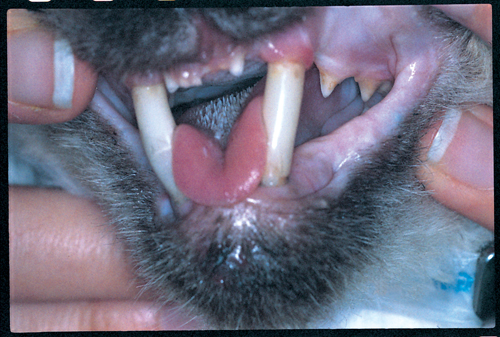Difference between revisions of "Small Animal Orthopaedics Q&A 03"
| Line 14: | Line 14: | ||
|a1= | |a1= | ||
Columns of dental composite have been used to bond the ipsilateral mandibular and maxillary canine teeth. Bonding of the canine teeth is a non-invasive means of stabilizing mandibular fractures. | Columns of dental composite have been used to bond the ipsilateral mandibular and maxillary canine teeth. Bonding of the canine teeth is a non-invasive means of stabilizing mandibular fractures. | ||
| − | |l1= | + | |l1= |
|q2=How should the canine teeth be prepared for this procedure? | |q2=How should the canine teeth be prepared for this procedure? | ||
|a2= | |a2= | ||
| Line 22: | Line 22: | ||
A primary concern is that the repair will eventually lead to proper occlusion. | A primary concern is that the repair will eventually lead to proper occlusion. | ||
| − | |l2= | + | |l2= |
</FlashCard> | </FlashCard> | ||
Revision as of 22:16, 23 October 2011
| This question was provided by Manson Publishing as part of the OVAL Project. See more Small Animal Orthopaedics Q&A. |
A photograph of the mouth of a cat which has undergone a stabilization procedure for a comminuted fracture of the angle of the left mandible.
| Question | Answer | Article | |
| What form of stabilization has been utilized? | Columns of dental composite have been used to bond the ipsilateral mandibular and maxillary canine teeth. Bonding of the canine teeth is a non-invasive means of stabilizing mandibular fractures. |
[[|Link to Article]] | |
| How should the canine teeth be prepared for this procedure? | The teeth should be cleaned with an ultrasonic scaler and pumiced. The canine teeth are then acid etched, rinsed and dried with a blow dryer. A thin layer of dental adhesive is then applied to the canine teeth. The fracture is held in reduction and the composite is applied. In this cat, plastic drinking straws were filled with composite material to form the columns. The fracture must be held in reduction until the composite has cured. A primary concern is that the repair will eventually lead to proper occlusion. |
[[|Link to Article]] | |
